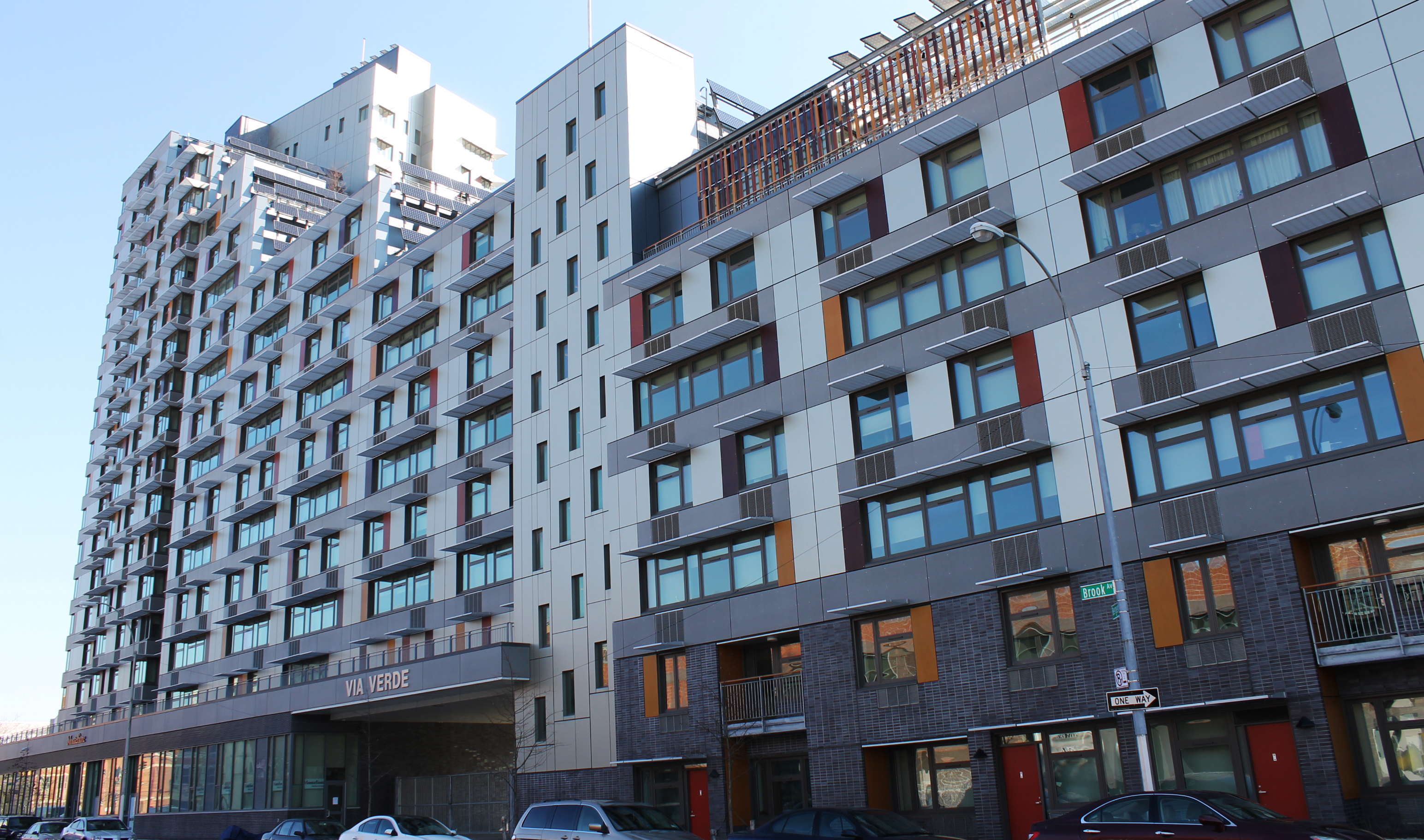
News
By LOCUS Admin, May 3, 2018
 Via Verda (or "green way" in Spanish) is a mixed-income housing development in New York City; the name is a reference to its green roofs. Located in the South Bronx, approximately two thirds of the units are affordable for low-income households with the other third for middle-income. The site is just blocks from a subway station and is served by multiple bus routes. (Photo: Jules Antonio, Flickr)
Via Verda (or "green way" in Spanish) is a mixed-income housing development in New York City; the name is a reference to its green roofs. Located in the South Bronx, approximately two thirds of the units are affordable for low-income households with the other third for middle-income. The site is just blocks from a subway station and is served by multiple bus routes. (Photo: Jules Antonio, Flickr)
Cities of all sizes are facing a shortage of housing for their poorest, most vulnerable residents. And a smaller set of booming cities are becoming completely unaffordable to even the middle class. To ensure enough attainable housing is built to satisfy demand, particularly as new transit service comes to an area and raises land values, such housing has to be planned for and spread out as much as possible.
We've all heard about the housing crisis plaguing different communities. Across the country, the supply of housing hasn’t kept up with demand and in some places, prices for even tiny apartments have become exorbitant. As more people move to urban areas and seek out a finite supply of walkable development, lower-income and middle-class households have been forced to the urban periphery to find reasonably priced places to live, work, and play.
Last month’s LOCUS Leadership Summit: Rebuild America’s Neighborhoods offered attendees a unique opportunity to gain insight into solving the nation’s attainable housing crisis. Featuring experts from the U.S. Department of Housing and Urban Development (HUD), the Natural Resources Defense Council, the Urban Land Conservancy, and Smart Growth America, “Best Practices: Zoning for Revitalization without Displacement” discussed how to ensure enough attainable housing is built to satisfy demand.
According to Harriet Tregoning, a former official in the Office of Community Planning at HUD, getting ahead of the curve and planning for affordable housing is key, especially as new transit service is expected to arrive.
"If you plan for success and it takes a few more years , the cost is pretty small," she explained. However, if a locality misses this chance and doesn’t have the zoning in place that allows for the type of development a community needs and the density to support transit, "the results devastating."
Without an explicit commitment (financial and political) to affordable housing and commercial space up front, the opportunity can be lost. Pent-up market demand will drive up land prices which favor higher-end market rate apartments and condos and credit-worthy commercial tenants.
It's not just about the quantity, though. The location is equally important. Tregoning talked about how developers will often push back on requirements for affordable housing in expensive neighborhoods. In lieu of meeting those requirements in the more desirable or transit-accessible neighborhood, they may ask if they can build affordable housing in a nearby (and cheaper) area instead. The developer might even promise more affordable units at the alternate location than originally planned or required in the original project. That might make sense until, as a result, all affordable housing is concentrated in the same few areas. Majora Carter, the Summit keynote, spoke more about why concentrating affordable housing and poverty is so problematic.
Inventory, estimate, and integrate
As more and more cities expand and build new light rail lines and other high-capacity transit services, they should be thinking about attainable housing and affordable commercial space strategies from the beginning. It can be really hard to dig yourself out of a housing affordability problem, which is why baking it into their plans for transit-oriented development around stations is so important. Assume that your efforts will be successful before you ever get started.
The first step to handling the problem is understanding where you’re at, i.e. an inventory of affordable housing, as Chris Zimmerman, vice president for economic development at Smart Growth America explained. In such an inventory, it is important to distinguish between legally rent-controlled or otherwise subsidized housing and market-rate housing supporting lower-income renters that is simply affordable in the current market. It’s the latter, market-rate affordable housing, that is most at risk of disappearing as prices go up, in turn displacing residents.
How much prices will rise and the impact that will have on housing costs and displacement can be estimated with modeling. Using historic home prices and the impact of transit investments elsewhere in the region is one way to arrive at such an estimate. Once you know more about the existing housing stock and have an idea of the changes in store, you can begin to set goals and targets and integrate those into land use plans and development implementation.
Zoning is an important part of the equation and can remove a lot of barriers to building affordable housing. But zoning is just one of many tools that can be used to encourage (or mandate) the construction of affordable housing and ensure that that housing is dispersed.
With the right zoning, planning, incentives, and a proactive approach, it's possible to not only preserve the existing amount of affordable housing in an area that may be ripe for gentrification (and thus help prevent displacement) but even expand the amount of affordable housing.
Related News

© 2025 Smart Growth America. All rights reserved
Site By3Lane Marketing












